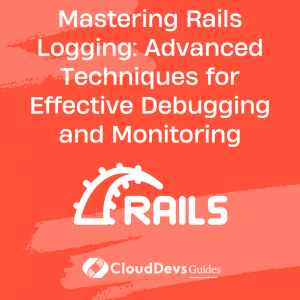Mastering Rails Logging: Advanced Techniques for Effective Debugging and Monitoring
Table of Contents
Logging is a crucial aspect of any application’s development and maintenance process. In this blog post, we will explore advanced logging techniques in Ruby on Rails, focusing on how to improve debugging, error tracking, and application monitoring. We will dive into various aspects of Rails logging, including custom log formats, log levels, logging in different environments, logging for specific components, log rotation, log filtering, and integrating with external log management systems. By implementing these advanced techniques, you can gain deeper insights into your Rails application, troubleshoot issues more effectively, and enhance its overall stability and performance.
1. Understanding Rails Logging Basics:
We start by reviewing the fundamentals of Rails logging. We discuss the default logging configuration in Rails, log levels, and the role of log files. We also introduce the concept of loggers and the ActiveSupport::Logger class.
2. Custom Log Formats and Log Levels:
We explore how to customize log formats to include additional information such as timestamps, request IDs, and user context. We also discuss how to adjust log levels to filter or include specific log messages based on their importance or severity.
3. Logging in Different Environments:
We dive into configuring logging in different Rails environments, such as development, test, and production. We discuss the importance of adjusting log levels, log file paths, and log rotation settings based on the specific requirements and constraints of each environment.
4. Component-Specific Logging:
We explore techniques for implementing component-specific logging in Rails. We discuss how to define custom loggers for specific components, such as controllers, models, or background jobs, to isolate and fine-tune the logging behavior for each component.
5. Log Rotation and Management:
We delve into log rotation and management strategies to handle large log files effectively. We discuss techniques for rotating logs based on size or time intervals, compressing old log files, and configuring log retention policies.
6. Log Filtering and Anonymization:
We discuss techniques for filtering sensitive information from logs, such as user passwords or credit card details, to ensure data privacy and security. We explore options for implementing log anonymization to protect user identities while still retaining useful debugging information.
7. Integration with External Logging Systems:
We showcase how to integrate Rails logging with external log management systems. We discuss popular log aggregation tools like Elasticsearch, Logstash, and Kibana (ELK stack), as well as cloud-based logging services like Papertrail and LogDNA. We explore techniques for forwarding Rails logs to these systems for centralized monitoring and analysis.
8. Advanced Logging Techniques:
We cover advanced logging techniques, including structured logging, tagging log entries, and using contextual logging to provide additional context for log messages. We discuss how these techniques can enhance log analysis and troubleshooting capabilities.
9. Conclusion:
By mastering advanced logging techniques in Ruby on Rails, you can significantly improve your application’s debugging, error tracking, and monitoring capabilities. We explored custom log formats, log levels, logging in different environments, component-specific logging, log rotation, log filtering, and integration with external log management systems. Implementing these techniques will empower you to gain valuable insights, quickly identify and resolve issues, and maintain a robust and performant Rails application.



